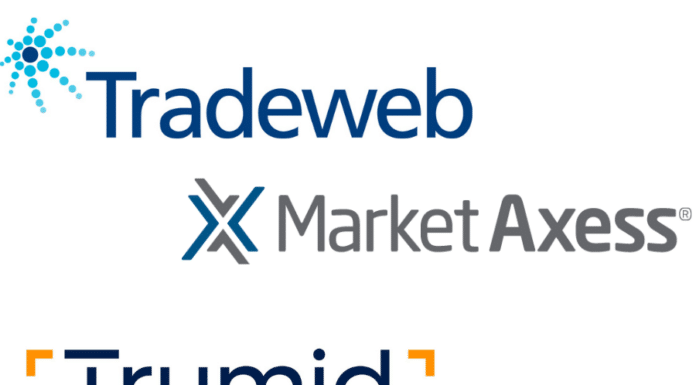Efforts are underway to automate debt offerings and give the buy side greater control. Lynn Strongin Dodds reports.
Initial public and debt offerings can be messy affairs, subject to human error and frailty thanks to the largely manual processes. The UK’s Financial Conduct Authority (FCA) is currently investigating the equity primary market for conflicts of interest amongst dealers, after analysis showed they may give preference to investor clients.
There have been many attempts to improve issuance but over the last couple of years the pace of progress has accelerated. Equities have been at the forefront of the initiatives but attention has moved towards the trickier fixed income markets, as debt issuance exploded in low interest rate markets.
Recent volatility may have given corporates pause for thought but as of mid-April, Dealogic figures show US investment grade (IG) issuance totalled US$290 billion year to date, reaching a record high for the third consecutive period, and up 4% from the same timeframe last year. Overall volume in 2015 reached the new height of US$1.31 trillion compared to US$1.19 trillion in 2014.
US corporates are set to make an even bigger splash this year in Europe than last, where they were the biggest borrowers in euros, accounting for 22% of the E269 billion of investment-grade corporate debt sales.
Getting a piece of the action has become more challenging because the window to analyse deals, indicate interest, price, and allocate has shrunk. The traditional way of matching orders between fund managers and bank underwriters by phone, fax and email is too slow. Requests can go missing and instructions mis-typed which not only slows down the process but also hampers a firm’s ability to comply with the various regulatory requirements.
These could be the largest orders a trading desk places and there has been recognition for some time that the systems needed to be automated, according to Scott Atwell, manager of FIX Trading and connectivity at American Century Investments, a buy-side firm with US$141 billion in assets under management.
The path ahead
The International Primary Market Association started the ball rolling over a decade ago, but last year the Buy-Side Working Group at the FIX Trading Community published a best practices document for the automation of the initial public offering (IPO) process.
The paper recommended creating a straight-through-process to electronically send new issue orders using the FIX Protocol from an asset manager’s order management system to the syndication. The aim was to create a system that would be aligned with the same procedure used for secondary market orders and trade fills. This would also address concerns around conflicts of interest.
“The main focus is not to redefine but automate the process in order to reduce risk, increase transparency and improve efficiency,” says Atwell. “Other benefits include an improved audit trail which might provide regulators with better oversight. We have just recently moved from concept to prototype this year but it is still early days and ironically there have not been that many IPOs. Although our initial launch has been in equities, everything we identify in the document should work for fixed income.”
Gherardo Lenti Capoduri, head of Market Hub, the electronic trading platform run by Banca IMI, also believes that automation would be more efficient as it could enhance speed, reliability and cost effectiveness. “This process is ongoing in order to prevent the effects from secondary markets and to avoid a lack of confidence in primary market issuance as actual market changes are affecting the entire marketplace,” he adds.
He believes that improved electronic auction systems could be important for streamlining the process of submitting bids so that auction results can be processed and disseminated more quickly. In addition, more sophisticated systems are also needed to allow institutions to bid directly in auctions. However the differences between equity and fixed income instruments will mean the process is not straightforward.
Adam Conn, head of dealing at Baring Asset Management and former co-chair FIX Trading Community Global Buy-Side Committee, says, “For example, the size of the orders is not the same and there are typically fewer syndicate members in a fixed income new issue deal compared to an equity IPO. There are also technical issues such as the need to create universal market standard security identifiers because the deals are often done overnight or the same day and the information is not always available when the deal goes live.”
Gaining agreement is no easy task. Take the International Securities Identification Numbers (ISINs) which are issued by national numbering agencies. Although they are currently the global standard in several European countries, others opt for the Alternative Instrument Identifiers (AIIs).
Another challenge is providing the capability for brokers or the syndication desk to amend details of the deal as they change. Moreover, “syndication desks also want to have the comfort knowing that an order clears pre-trade compliance,” Conn adds. “This helps reduces the risk of order inflation.”
The technical challenge
Vendors including Dealogic for equities and Ipreo – a joint venture owned by a unit of Goldman Sachs Group and Blackstone Group – for fixed income have been busy developing solutions. The former is already testing the waters with around 20 buy-side firms in a pilot programme that allows them to place orders and receive allocations electronically for the first time.
Ipreo has developed book-building solutions to manage demand, implemented syndicate-to-syndicate communication networks, and provided tools to ensure issuers are informed as the deal progresses. It is also in the testing phase with Investor Access, a system designed to notify investors of new-issue announcements, thereby allowing them to submit indications of interest and receive notification of allocation and pricing details electronically. To date, eleven banks including BNP Paribas, HSBC, Societe Generale, Banco Santander, Commerzbank, Credit Agricole and ING Group have joined the initiative. Every deal will get an identifier whether it is ISIN or CUSIP, the North American version of ISIN. Ipreo hopes to launch the platform later this year in Europe and Asia.
Again greater transparency is at the core, but it also fits neatly into European regulation, which is looking to tighten rules on issuance of securities to remove conflicts of interest between underwriters and their clients. The objective is to prevent banks that have been underwriting record amounts of corporate bonds from distributing them to customers willing to pay higher fees or put extra business their way in return.
Herb Werth, managing director, global buy-side, Ipreo believes Investor Access will enable the buy side to participate in a more effective way. “For example, if there is a single issue brought to market then the manual processes and procedures can handle it. The problem comes when there is a great deal of issuance. This creates a lot of strain on both sides. The buy side wants to ensure that their portfolio managers can see all of the deals in the market and would prefer to get the data in a structured form so it can be more easily consumed.”
Cautious optimism
“Inserting an electronic process between the buy and sell side will not in and of itself change the relationship between the issuer and investor,” says one industry participant. “There is still the syndication of banks that handle the deal. However, what it does do is give the buy side greater control of its orders in that they send them electronically to the syndicate directly versus using a messaging format.”
Lenti Capoduri agrees, adding, that in many cases large buy-side firms hold most of the inventory of new issues and they want more control and predictability over market infrastructure alterations. “Changes in issuance policies, procedures and portfolio management strategies can influence the issuance process,” he adds. “This also happens in the primary process where the combination of automation and stricter transparency rules helps buy-side traders influence the total issuance process.”
He does not think though that there will be only one solution to the lack of confidence in primary market issuance. Automation might pave the way for a more transparent and standardised process but that does not mean a move towards the equitisation of bonds trading.
“Diversification of the primary issuance models that takes account of the differences in instrument type, liquidity and maturity, and of the issuers and investors strategy, might be a better solution for the future of bond markets,” he says.
Primary effect – Recognition of the effect that primary markets have on the secondary market has been growing.
In September 2014, asset management giant BlackRock made the case for reducing and standardising issued fixed income instruments, in effect boosting liquidity by cutting the number of bonds in the market and simplifying trading.
In November 2015, the European Parliament proposed removing a regulatory incentive to issue bonds of E100,000+ in European credit, in the hope that smaller sizes would attract retail investors and boost liquidity.
©TheDESK 2016
©Markets Media Europe 2025










